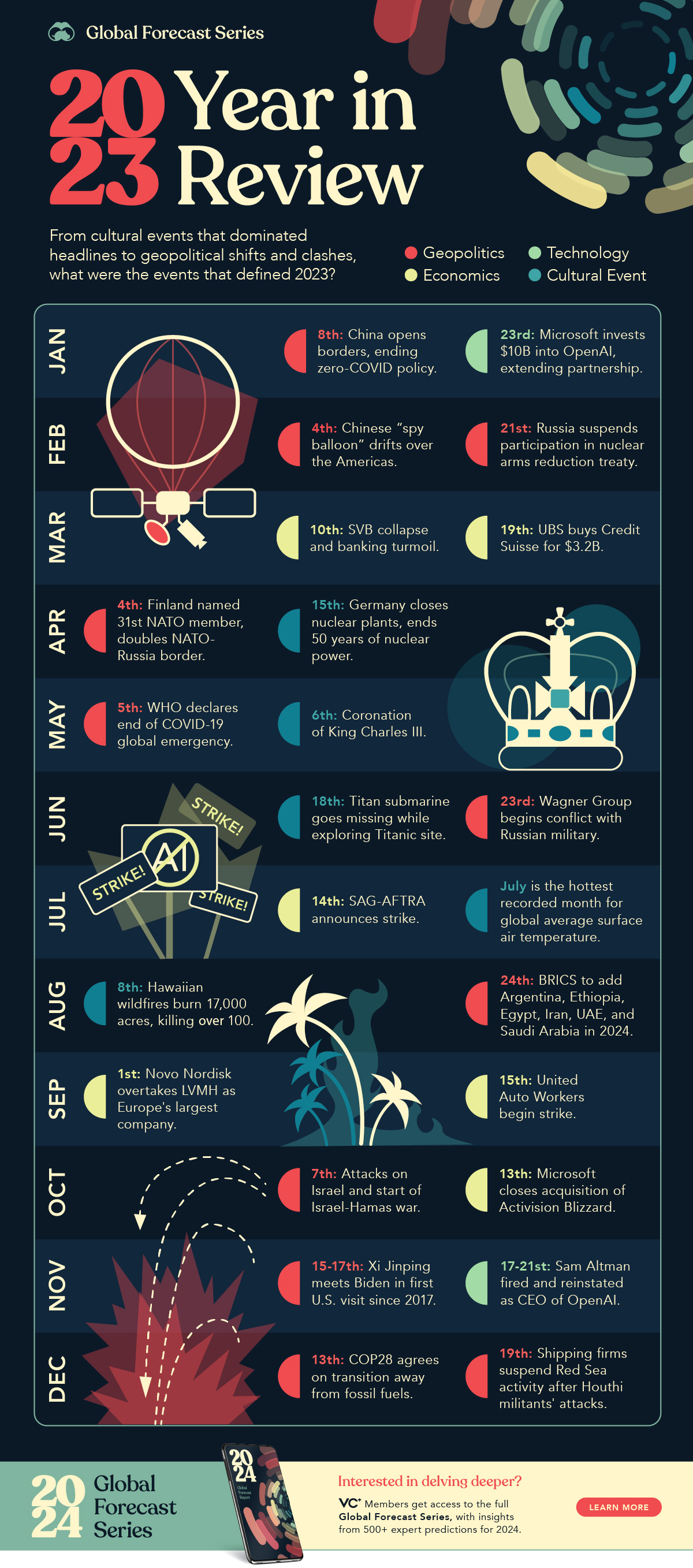Markets
The Events that Defined 2023: Visualized
This visual is part of our 2024 Global Forecast Series. For full access to the series, learn more here.

Visualizing the Major Events of 2023
Looking back at 2023, the year was defined by various international geopolitical events while the tech and business world kept a close eye on artificial intelligence’s advances in the first full year of the technology hitting its stride.
This graphic from our upcoming 2024 Global Forecast Report looks back at the major events that dominated the headlines and captured the world’s attention in 2023.
From the AI tech boom to the various hot and cold conflicts around the world, many of this past year’s pivotal events will have continuing aftershocks and developments to track in 2024.

The Major Geopolitical Events of 2023
Geopolitics were in the spotlight in 2023 after Russia’s invasion of Ukraine shifted global power dynamics and international relations towards a multipolar environment.
As a result, tensions remained high between the U.S. and China throughout the year while various conflicts continued and sprung up in other regions.
China’s COVID Reopening and Spy Balloon Amidst Russia-NATO entrenchment
In the first two months of the year China dominated news headlines as the country reopened its borders and business, ending its highly restrictive zero-COVID measures and policy. The world’s manufacturing powerhouse was one of the last nations to loosen restrictions, and many anticipated it would kickstart the final leg of the world’s post-pandemic recovery.
However, in early February the discovery of what was dubbed a “spy balloon” floating over the U.S. and Canada quickly put China-U.S. relations on edge while Russia also suspended its participation in New START, a nuclear arms reduction treaty that would’ve allowed U.S. and NATO inspections of the country’s nuclear facilities.
Finland’s acceptance into NATO in April then doubled the alliance’s border with Russia, making it a key area to watch in 2024 as a senior Russian diplomat was quoted, saying that in the event of an escalation Finland would be the first to suffer.
BRICS Expansion and Xi Jinping’s Visit to the U.S.
June brought an unexpected internal clash in Russia as the Wagner Group briefly turned against the Russian military, with the mercenary group’s leader Yevgeny Prigozhin dying a couple months later in an airplane crash.
August also brought the BRICS bloc’s announcement of the addition of six new members starting in 2024, marking a key shift in geopolitical relations as the group added major oil producers Saudi Arabia, Iran, and the United Arab Emirates, along with Egypt, Ethiopia, and Argentina.
After nearly a year of further entrenchment in the newly fractured geopolitical landscape, November saw U.S.-China relations thaw as Xi Jinping met with Joe Biden in his first visit to the U.S. since 2017.
Israel-Hamas War and Red Sea Shipping Attacks
While relations between U.S. and China improved in the last quarter of 2023, new conflicts sprung up in other parts of the world.
Hamas’ attacks on Israel on October 7th kicked off Israel’s war against Hamas, which has been followed by Houthi rebel attacks on shipping lines in the Bab el-Mandeb Strait of the Red Sea.
The low-cost drone attacks have resulted in many major shipping firms redirecting their container-ships around all of Africa (extending their journeys by as much as 25%), while the U.S. has grappled with the advent of low-cost drone warfare costing the country millions in missiles as they’ve looked to protect ships in the strait.
Both the Israel-Hamas war and rebel attacks in the Red Sea remain two of the largest question marks around global tensions and affecting supply chains going into 2024.
OpenAI’s Roller Coaster Year
It would be impossible to talk about 2023 without mentioning the roller coaster year OpenAI has had in the spotlight of the AI gold rush.
The year started with Microsoft extending its investment and partnership with OpenAI by $10 billion, as Sam Altman’s company went on to launch its more powerful GPT-4 model along with other key features throughout the year like image recognition, image generation, and deeper custom model instructions with custom GPTs.
While the year seemed to be progressing perfectly for OpenAI at the forefront of the AI hype wave, the end of November saw Sam Altman fired as CEO of the company in one of the most shocking board decisions in recent business history. Sam Altman was reinstated as CEO within 72 hours, giving the tech world just a few days of pause to reflect on the issues of governance and leadership in one of the fastest growing industries.
Markets
Mapped: Europe’s GDP Per Capita, by Country
Which European economies are richest on a GDP per capita basis? This map shows the results for 44 countries across the continent.

Mapped: Europe’s GDP Per Capita, by Country (2024)
This was originally posted on our Voronoi app. Download the app for free on iOS or Android and discover incredible data-driven charts from a variety of trusted sources.
Europe is home to some of the largest and most sophisticated economies in the world. But how do countries in the region compare with each other on a per capita productivity basis?
In this map, we show Europe’s GDP per capita levels across 44 nations in current U.S. dollars. Data for this visualization and article is sourced from the International Monetary Fund (IMF) via their DataMapper tool, updated April 2024.
Europe’s Richest and Poorest Nations, By GDP Per Capita
Luxembourg, Ireland, and Switzerland, lead the list of Europe’s richest nations by GDP per capita, all above $100,000.
| Rank | Country | GDP Per Capita (2024) |
|---|---|---|
| 1 | 🇱🇺 Luxembourg | $131,380 |
| 2 | 🇮🇪 Ireland | $106,060 |
| 3 | 🇨🇭 Switzerland | $105,670 |
| 4 | 🇳🇴 Norway | $94,660 |
| 5 | 🇮🇸 Iceland | $84,590 |
| 6 | 🇩🇰 Denmark | $68,900 |
| 7 | 🇳🇱 Netherlands | $63,750 |
| 8 | 🇸🇲 San Marino | $59,410 |
| 9 | 🇦🇹 Austria | $59,230 |
| 10 | 🇸🇪 Sweden | $58,530 |
| 11 | 🇧🇪 Belgium | $55,540 |
| 12 | 🇫🇮 Finland | $55,130 |
| 13 | 🇩🇪 Germany | $54,290 |
| 14 | 🇬🇧 UK | $51,070 |
| 15 | 🇫🇷 France | $47,360 |
| 16 | 🇦🇩 Andorra | $44,900 |
| 17 | 🇲🇹 Malta | $41,740 |
| 18 | 🇮🇹 Italy | $39,580 |
| 19 | 🇨🇾 Cyprus | $37,150 |
| 20 | 🇪🇸 Spain | $34,050 |
| 21 | 🇸🇮 Slovenia | $34,030 |
| 22 | 🇪🇪 Estonia | $31,850 |
| 23 | 🇨🇿 Czech Republic | $29,800 |
| 24 | 🇵🇹 Portugal | $28,970 |
| 25 | 🇱🇹 Lithuania | $28,410 |
| 26 | 🇸🇰 Slovakia | $25,930 |
| 27 | 🇱🇻 Latvia | $24,190 |
| 28 | 🇬🇷 Greece | $23,970 |
| 29 | 🇭🇺 Hungary | $23,320 |
| 30 | 🇵🇱 Poland | $23,010 |
| 31 | 🇭🇷 Croatia | $22,970 |
| 32 | 🇷🇴 Romania | $19,530 |
| 33 | 🇧🇬 Bulgaria | $16,940 |
| 34 | 🇷🇺 Russia | $14,390 |
| 35 | 🇹🇷 Türkiye | $12,760 |
| 36 | 🇲🇪 Montenegro | $12,650 |
| 37 | 🇷🇸 Serbia | $12,380 |
| 38 | 🇦🇱 Albania | $8,920 |
| 39 | 🇧🇦 Bosnia & Herzegovina | $8,420 |
| 40 | 🇲🇰 North Macedonia | $7,690 |
| 41 | 🇧🇾 Belarus | $7,560 |
| 42 | 🇲🇩 Moldova | $7,490 |
| 43 | 🇽🇰 Kosovo | $6,390 |
| 44 | 🇺🇦 Ukraine | $5,660 |
| N/A | 🇪🇺 EU Average | $44,200 |
Note: Figures are rounded.
Three Nordic countries (Norway, Iceland, Denmark) also place highly, between $70,000-90,000. Other Nordic peers, Sweden and Finland rank just outside the top 10, between $55,000-60,000.
Meanwhile, Europe’s biggest economies in absolute terms, Germany, UK, and France, rank closer to the middle of the top 20, with GDP per capitas around $50,000.
Finally, at the end of the scale, Eastern Europe as a whole tends to have much lower per capita GDPs. In that group, Ukraine ranks last, at $5,660.
A Closer Look at Ukraine
For a broader comparison, Ukraine’s per capita GDP is similar to Iran ($5,310), El Salvador ($5,540), and Guatemala ($5,680).
According to experts, Ukraine’s economy has historically underperformed to expectations. After the fall of the Berlin Wall, the economy contracted for five straight years. Its transition to a Western, liberalized economic structure was overshadowed by widespread corruption, a limited taxpool, and few revenue sources.
Politically, its transformation from authoritarian regime to civil democracy has proved difficult, especially when it comes to institution building.
Finally, after the 2022 invasion of the country, Ukraine’s GDP contracted by 30% in a single year—the largest loss since independence. Large scale emigration—to the tune of six million refugees—is also playing a role.
Despite these challenges, the country’s economic growth has somewhat stabilized while fighting continues.
-

 Mining6 days ago
Mining6 days agoWhere the World’s Aluminum is Smelted, by Country
-

 Markets2 weeks ago
Markets2 weeks agoVisualized: Interest Rate Forecasts for Advanced Economies
-

 Economy2 weeks ago
Economy2 weeks agoThe Most Valuable Companies in Major EU Economies
-

 Markets2 weeks ago
Markets2 weeks agoThe World’s Fastest Growing Emerging Markets (2024-2029 Forecast)
-

 Markets2 weeks ago
Markets2 weeks agoVisualizing Global Inflation Forecasts (2024-2026)
-

 Misc1 week ago
Misc1 week agoCharted: What Southeast Asia Thinks About China & the U.S.
-

 Misc1 week ago
Misc1 week agoThe Evolution of U.S. Beer Logos
-

 Healthcare1 week ago
Healthcare1 week agoWhat Causes Preventable Child Deaths?















